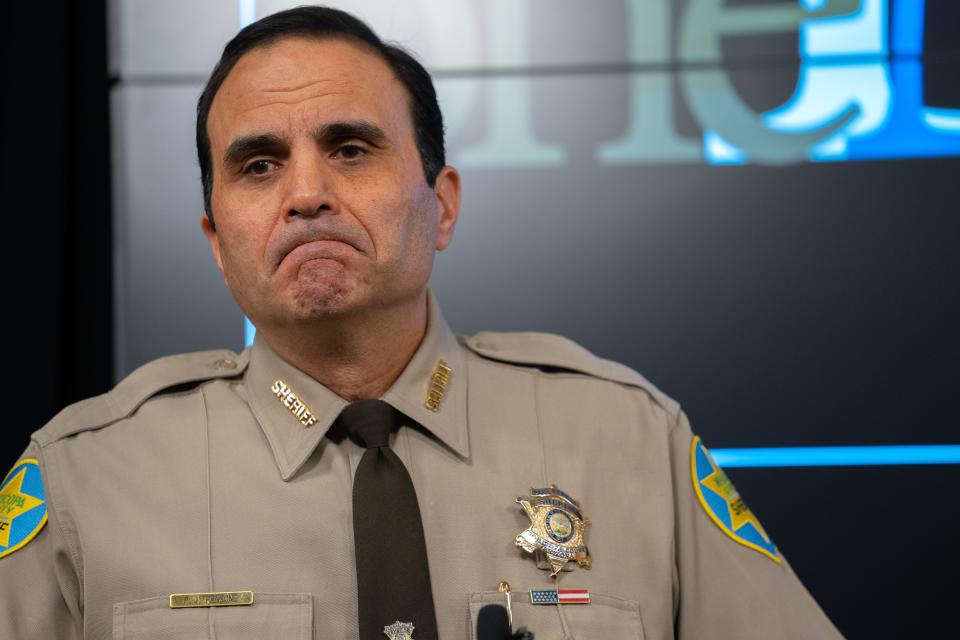A 2008 racial profiling case has cost Maricopa County about $215 million — and counting

Nearly a decade after a federal judge found that the Maricopa County Sheriff’s Office racially profiled Latino drivers and about 15 years after the case was first introduced, the department still isn’t in compliance with court orders and is racking up increasingly more costs each year.
The class-action suit, initially filed against former Sheriff Joe Arpaio in 2008, has cost Maricopa County taxpayers $215 million and counting — including a little under $15 million since the start of this fiscal year in July.
Officials say the department has made “significant progress” toward complying with two court orders handed down by U.S. District Judge G. Murray Snow, one in 2013 and another in 2016. Sheriff Paul Penzone was elected in 2017 as a reformer and officials say the department has gotten more diverse under his tenure.
But in November, Snow found Penzone in contempt of court for slow work on his earlier orders.
That contempt order focuses on a backlog of internal investigations into employee misconduct, part of an accountability system set up by Snow's earlier rulings on the case. More than 2,100 investigations are pending at the department, Snow said, and it takes the Sheriff's Office more than 600 days on average to close them. The length of time to investigate complaints has been rising each year, raising questions about Penzone’s ability to address them appropriately.
And as the case drags on, records obtained by The Arizona Republic show that the costs of personnel and equipment linked to the orders have ballooned in recent years, even as expenses associated with attorneys and other legal fees have stayed mostly stagnant.
In 2014, a year after Snow issued his first court order in the case, the department spent about $3 million on personnel and equipment toward achieving compliance. The year after, it spent $12 million, and then another $8 million in 2016.
But beginning in 2017, the costs began to consistently increase year over year. They jumped to a high of $25.5 million in the 2022 fiscal year — a little over $2 million per month.
A slow trudge toward compliance
Snow's first two orders contain a combined 205 mandates. Currently, the Sheriff's Office is in compliance with 138 of them, according to spokesperson Norma Gutierrez Deorta.
For the Sheriff's Office, complying with the orders means being in "full and effective" compliance, Gutierrez Deorta said.
"In its orders, the court has stated that compliance is only satisfied when MCSO is a minimum standard of 94% compliant in every paragraph of the order for three straight years," she said.
That means that the Sheriff's Office must demonstrate that it is fully complying with order requirements more than 94% of the time, or in upwards of 94% of incidents reviewed by the monitor. Currently, the department is working toward full compliance on 40 demands, Gutierrez Deorta said, and is not in compliance with 27.
"Substantial steps have been taken on all of those," she said.
Keep reading:Judge cites Maricopa County Sheriff Paul Penzone with contempt in racial profiling case
To track the Sheriff's Office's progress, the court's monitor has divided each requirement into two areas of measurement: phase 1, which examines whether the department has developed and approved requisite policies and procedures, and phase 2, which measures operational implementation.
Since Penzone took office, Gutierrez Deorta said the department has gone from 60% phase 1 compliance and 49% phase 2 compliance to 99% phase 1 compliance and 78% phase 2 compliance for the court's first order. For the second order, Penzone started at 1% phase 1 compliance and 43% phase 2 compliance. Now, those numbers are 100% and 93%, respectively.
But in recent months, some of those compliance numbers have trended downwards. The court monitor's most recent compliance write-up, released in December, reports a 2% drop in phase 2 compliance for the first order. Other compliance numbers remained steady from the monitor's previous report in June.
What's holding the Sheriff's Office back?

While addressing Snow's contempt of court citation in November, Penzone said the Sheriff's Office's progress had been hampered by several large-scale issues in recent years, including COVID-19, protests, election security and the fentanyl crisis.
“Public safety remains my top priority while continuing to come into compliance with the court’s requirements,” Penzone said in an interview with The Republic. “We will continue to move forward.”
He also pointed to difficulty in retaining and hiring. The office currently has 220 civilian vacancies, 84 deputy sheriff vacancies and 651 detention vacancies, Gutierrez Deorta said.
More on the case:Maricopa County Sheriff's Office was ordered to stop racial profiling under Joe Arpaio. It's still happening
"We continue to have high vacancy rates despite extraordinary recruiting efforts," she said.
Officials attribute that to a variety of issues. All law enforcement agencies are coming up against a tight hiring market, Gutierrez Deorta said. Filing high-level roles, such as positions in the compliance division, requires candidates to have little or no history of discipline. Those positions also draw from other parts of the department that are already understaffed.
But at least part of the problem may be that the Sheriff's Office's legal problems are well-known to candidates.
"The federal court oversight may make MCSO less appealing to prospects interested in law enforcement," Gutierrez Deorta said.
Nevertheless, Gutierrez Deorta said officials have tried to improve hiring.
She pointed to increased diversity within its workforce as evidence of progress made. The Sheriff's Office currently employs nearly 3,000 employees. Of those, about 53% are white, 31% are Latino, 7% are Black, 3% are Asian and 6% identify as mixed race or of a different ethnicity.
Those stats are up from 2017, when about 27% of the Sheriff's Office's employees were Latino and 6% were Black.
Gutierrez Deorta said the department has also offered signing bonuses for some positions, increased advertising for vacancies and shortened the hiring process in an effort to get more qualified applicants on board.
Why costs may not go down

Once the Sheriff's Office hits minimum compliance, Gutierrez Deorta said the department believes Snow will drop the monitoring requirement.
The Sheriff's Office didn't provide a timeframe in which that's expected to happen. But when it does, it will mean the county will spend money on the legal side.
Still, the amount of money the department spends on personnel and equipment — the bulk of its expenses related to the lawsuit — is unlikely to go down.
Gutierrez Deorta said money going toward compliance has funded new positions, supplies and studies that have become "the new benchmark or standard" for the Sheriff's Office's policing. Those costs aren't going away, and will increase as inflation continues.
"Even as we become compliant, many of these costs will remain as removing them could jeopardize future compliance," Gutierrez Deorta said.
Sasha Hupka covers Maricopa County, Pinal County and regional issues for The Arizona Republic. Do you have a tip on the money or politics of a county department? Reach her at [email protected]. Follow her on Twitter: @SashaHupka.
This article originally appeared on Arizona Republic: A 2008 racial profiling case has cost Maricopa County about $215M
